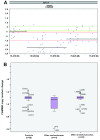Genome-wide analysis of Ollier disease: Is it all in the genes?
- PMID: 21235737
- PMCID: PMC3027091
- DOI: 10.1186/1750-1172-6-2
Genome-wide analysis of Ollier disease: Is it all in the genes?
Abstract
Background: Ollier disease is a rare, non-hereditary disorder which is characterized by the presence of multiple enchondromas (ECs), benign cartilaginous neoplasms arising within the medulla of the bone, with an asymmetric distribution. The risk of malignant transformation towards central chondrosarcoma (CS) is increased up to 35%. The aetiology of Ollier disease is unknown.
Methods: We undertook genome-wide copy number and loss of heterozygosity (LOH) analysis using Affymetrix SNP 6.0 array on 37 tumours of 28 Ollier patients in combination with expression array using Illumina BeadArray v3.0 for 7 ECs of 6 patients.
Results: Non-recurrent EC specific copy number alterations were found at FAM86D, PRKG1 and ANKS1B. LOH with copy number loss of chromosome 6 was found in two ECs from two unrelated Ollier patients. One of these patients also had LOH at chromosome 3. However, no common genomic alterations were found for all ECs. Using an integration approach of SNP and expression array we identified loss as well as down regulation of POU5F1 and gain as well as up regulation of NIPBL. None of these candidate regions were affected in more than two Ollier patients suggesting these changes to be random secondary events in EC development. An increased number of genetic alterations and LOH were found in Ollier CS which mainly involves chromosomes 9p, 6q, 5q and 3p.
Conclusions: We present the first genome-wide analysis of the largest international series of Ollier ECs and CS reported so far and demonstrate that copy number alterations and LOH are rare and non-recurrent in Ollier ECs while secondary CS are genetically unstable. One could predict that instead small deletions, point mutations or epigenetic mechanisms play a role in the origin of ECs of Ollier disease.
Figures



References
-
- Lucas DR, Bridge JA. In: World Health Organization classification of tumours. Pathology and genetics of tumours of soft tissue and bone. Fletcher CDM, Unni KK, Mertens F, editor. Lyon: IARC Press; 2002. Chondromas: enchondroma, periosteal chondroma, and enchondromatosis; pp. 237–240.
-
- Mertens F, Unni KK. In: World Health Organization Classification of Tumours. Pathology and genetics of tumours of soft tissue and bone. Fletcher CDM, Unni KK, Mertens F, editor. Lyon: IARC Press; 2002. Enchondromatosis: Ollier disease and Maffucci syndrome; pp. 356–357.
-
- Bovée JVMG, Hogendoorn PCW, Wunder JS, Alman BA. Cartilage tumours and bone development: molecular pathology and possible therapeutic targets. Nat Rev Cancer. 2010;10:481–488. - PubMed
-
- Khurana J, Abdul-Karim F, Bovée JVMG. In: World Health Organization classification of tumours. Pathology and genetics of tumours of soft tissue and bone. Fletcher CDM, Unni KK, Mertens F, editor. Lyon (France): IARC Press; 2002. Osteochondroma; pp. 234–236.
Publication types
MeSH terms
LinkOut - more resources
Full Text Sources
Medical
Molecular Biology Databases
Research Materials

